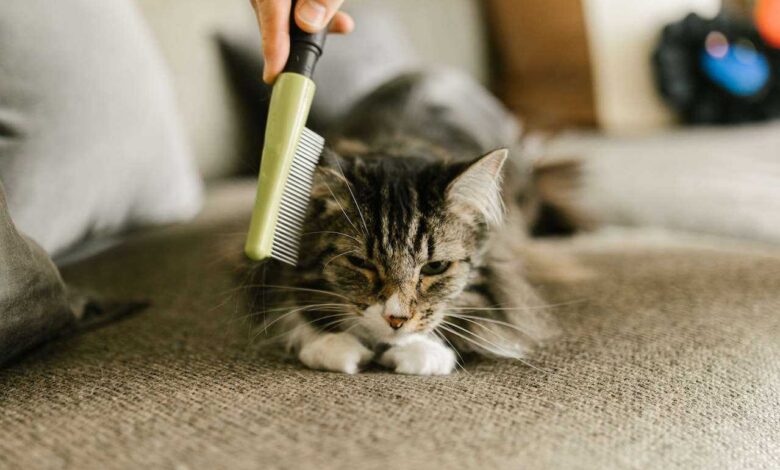
Dealing with matting and tangles fur can be a challenging task, but it’s essential for maintaining your pet’s comfort and health. In this comprehensive guide, we’ll explore the causes of matting and tangles, effective prevention strategies, and step-by-step methods for safely untangling those stubborn knots. Say goodbye to fur knots and hello to a happier, tangle-free pet!
Table of contents
Dealing with Matting and Tangles
What Causes Matting and Tangles?
Understanding the root causes of matting and tangles is crucial before addressing the issue. Several factors contribute to this problem:
- Fur Type: The type of fur your pet has plays a significant role. Long-haired breeds are more prone to matting, but it can affect any pet.
- Lack of Grooming: Regular grooming, especially brushing, helps remove loose fur, preventing it from forming knots. Neglecting grooming can lead to mats.
- Moisture and Dirt: Wet fur can mat quickly, as can fur with accumulated dirt, debris, or substances like food or urine.
- Pet’s Activity Level: Active pets are less likely to develop mats because their constant movement helps prevent fur from sticking together.
Prevention: Keeping Fur Tangle-Free
Regular Brushing
One of the most effective ways to prevent matting and tangles is through regular brushing. The choice of brush or comb depends on your pet’s fur type:
- Long-Haired Pets: For long-haired breeds, a slicker brush or a combination of slicker and wide-toothed combs is ideal. These tools reach deep into the coat to remove loose fur and prevent tangles.
- Short-Haired Pets: Short-haired pets benefit from rubber curry brushes or bristle brushes. These tools effectively remove loose fur and stimulate circulation, keeping the coat healthy.
Brushing not only removes loose fur but also stimulates circulation and distributes natural oils, promoting a healthy coat. Plus, it’s a wonderful bonding opportunity between you and your furry friend.
Bathing and Drying
Proper hygiene plays a significant role in preventing matting:
- Use Pet-Specific Shampoo: Select a shampoo that matches your pet’s fur type and avoid excessive bathing, as it can strip the coat of natural oils, making it more prone to matting.
- Dry Thoroughly: Ensure your pet is completely dry after a bath. Wet fur is more susceptible to matting. Use a clean towel to pat them dry or a low-heat setting on a pet-safe hairdryer.
Regular Haircuts
For long-haired breeds, consider regular haircuts or trims from a professional groomer. This can significantly reduce the risk of mats, especially in areas like the ears and tail. These trims not only keep your pet looking stylish but also help maintain their comfort and hygiene.
Untangling Mats and Tangles
Tools You’ll Need
Before embarking on the detangling process, gather the following tools:
- Detangling Spray or Conditioner: Look for a pet-friendly product designed to soften mats and make them easier to comb out.
- Detangling Brush or Comb: Choose a brush or comb appropriate for your pet’s fur type. For stubborn mats, a fine-toothed comb can be highly effective.
- Small Scissors: Only for carefully trimming stubborn mats. Ensure these scissors are pet-safe with rounded tips to avoid accidents.
The Untangling Process
Untangling mats and tangles requires patience and care. Follow these steps for a safe and effective process:
- Prepare Your Pet: Begin by ensuring your pet is comfortable and relaxed. Speak soothingly, offer treats, and create a stress-free environment.
- Apply Detangling Spray or Conditioner: Gently spray or apply the detangling product to the matted area. Allow it to sit for a few minutes to soften the fur. This step is critical as it makes the mats more pliable and reduces the risk of pulling or causing discomfort to your pet.
- Start at the Tips: Commence detangling at the tips of the fur, working your way up towards the mat. Employ slow, gentle strokes, and avoid any tugging. Applying too much pressure can be painful for your pet and make the process more challenging.
- Choose the Right Tool: Your choice between a brush or comb depends on the size and severity of the mats. Small mats may require a fine-toothed comb, while larger mats may be more efficiently tackled with a detangling brush.
- Exercise Patience: Untangling mats is a meticulous process that demands patience. Avoid rushing through it, and if your pet becomes distressed or uncomfortable, take breaks to soothe them.
- Trim as a Last Resort: In extreme cases, mats can be so tight that they cannot be untangled without causing undue stress or pain to your pet. In such situations, consider carefully trimming the mat with small, rounded-tip scissors. Take extreme caution to avoid cutting your pet’s skin, trimming only the mat itself.
Tips for Success
To ensure a successful untangling session, keep these tips in mind:
- Regular Maintenance: Prevention is the best approach. Make brushing a part of your pet’s routine, even if they don’t have mats. This not only prevents mats but also strengthens your bond.
- Use the Right Products: Invest in quality detangling sprays or conditioners designed for pets. Human products can be harsh on their skin.
- Professional Help: If you encounter mats that are too severe to handle yourself, seek professional help. Groomers have experience with difficult cases and can ensure your pet’s comfort and safety.
- Gentleness is Key: Always prioritize your pet’s comfort and well-being. Be gentle, patient, and attentive to their needs throughout the process.
DIY Detangling Solutions
For those who prefer natural or homemade solutions, there are DIY options to help with mat removal:
- Coconut Oil: Coconut oil can help soften mats and make them easier to comb out. Apply a small amount to the mat and let it sit for a few minutes before attempting to detangle.
- Cornstarch: Sprinkle a small amount of cornstarch on the mat, and gently work it in. This can help loosen the mat and make it easier to comb.
- Olive Oil: Similar to coconut oil, olive oil can be applied to the mat to soften it. Use it sparingly, and be sure to thoroughly wash it out afterward.
- DIY Detangling Spray: You can create your own detangling spray by mixing water and a small amount of conditioner. Spray this on the mat and follow the same detangling process as mentioned earlier.
Home Remedies for Matting and Tangles
In addition to DIY detangling solutions, there are home remedies that can help prevent matting and maintain your pet’s fur in top shape:
- Regular Baths: Regular, appropriate bathing can help keep your pet’s fur clean and less prone to matting. Use a pet-specific shampoo suitable for your pet’s fur type.
- Proper Nutrition: A healthy diet contributes to the overall condition of your pet’s coat. Ensure they are receiving the right nutrients for optimal fur health.
- Hydration: Proper hydration is essential for the quality of your pet’s skin and fur. Ensure they have access to fresh water at all times.
- Professional Grooming: Regular visits to a professional groomer can help keep your pet’s coat in excellent condition. They have the expertise and tools to address matting and tangles effectively.
Dealing with Matting and Tangles
Dealing with mats and tangles in your pet’s fur requires a combination of preventive measures, patience, and the right tools and products. Regular grooming, proper hygiene, and a gentle approach to untangling are essential for maintaining your pet’s comfort and well-being. Remember, prevention is the best strategy, so make brushing and grooming a part of your routine. With these tips and a little love and care, you can keep your pet’s fur tangle-free, healthy, and as soft as ever.









The interactive checklist for bringing home a new rescue was invaluable. I felt so prepared when our rescue puppy, Marley, arrived. The emotional support tips especially helped ease our first night jitters. Thank you!